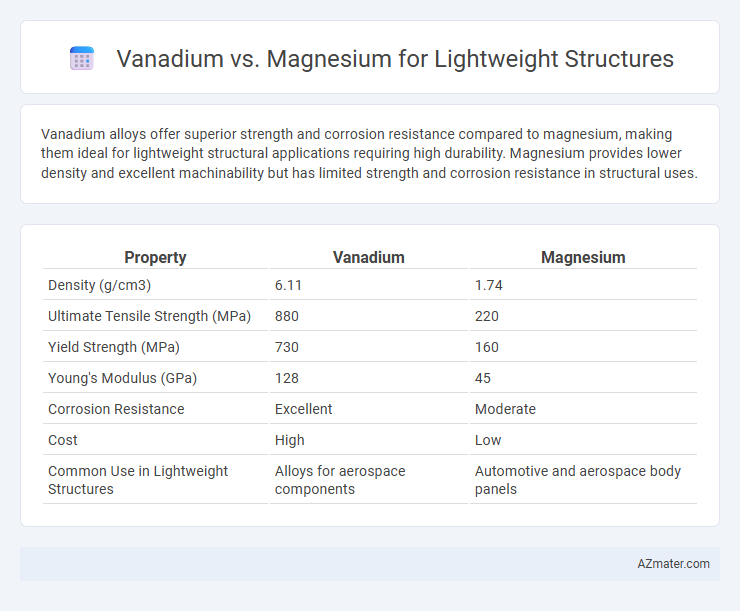Vanadium alloys offer superior strength and corrosion resistance compared to magnesium, making them ideal for lightweight structural applications requiring high durability. Magnesium provides lower density and excellent machinability but has limited strength and corrosion resistance in structural uses.
Table of Comparison
| Property | Vanadium | Magnesium |
|---|---|---|
| Density (g/cm3) | 6.11 | 1.74 |
| Ultimate Tensile Strength (MPa) | 880 | 220 |
| Yield Strength (MPa) | 730 | 160 |
| Young's Modulus (GPa) | 128 | 45 |
| Corrosion Resistance | Excellent | Moderate |
| Cost | High | Low |
| Common Use in Lightweight Structures | Alloys for aerospace components | Automotive and aerospace body panels |
Introduction to Lightweight Materials in Structural Engineering
Vanadium and magnesium are critical elements in advancing lightweight materials for structural engineering applications, with vanadium commonly used as an alloying agent to enhance the strength and durability of steel frameworks, while magnesium offers the lowest density among structural metals, significantly reducing overall weight. Magnesium's high strength-to-weight ratio and excellent machinability make it ideal for aerospace and automotive components, whereas vanadium's contribution to titanium and steel alloys improves resistance to fatigue and impact. Selecting between vanadium and magnesium depends on balancing factors such as mechanical performance, corrosion resistance, and cost to optimize lightweight structural designs.
Overview: Vanadium and Magnesium Properties
Vanadium exhibits exceptional strength, corrosion resistance, and high melting point, making it ideal for enhancing the durability of lightweight structures. Magnesium offers remarkable low density and excellent machinability, significantly reducing the overall weight of structural components. Combining vanadium's strength with magnesium's lightness can optimize lightweight structure performance for aerospace and automotive applications.
Strength-to-Weight Ratio Comparison
Vanadium alloys exhibit a superior strength-to-weight ratio compared to magnesium, making them ideal for lightweight structural applications requiring high strength and durability. Magnesium, while significantly lighter, generally provides lower tensile strength and fatigue resistance, which limits its use in high-stress environments. Vanadium's enhanced mechanical properties and corrosion resistance contribute to its effectiveness in aerospace and automotive components where optimal strength-to-weight performance is critical.
Corrosion Resistance: Vanadium vs Magnesium
Vanadium exhibits superior corrosion resistance compared to magnesium, especially in harsh environments where oxidation and chemical exposure are prevalent. Magnesium tends to corrode faster due to its high reactivity, requiring protective coatings to enhance durability in lightweight structural applications. Vanadium's stable oxide layer provides enhanced protection, making it a preferred choice for longevity in lightweight metal composites and alloys.
Manufacturing and Fabrication Challenges
Vanadium offers superior strength-to-weight ratio and excellent corrosion resistance compared to magnesium, but its high melting point and reactivity pose significant manufacturing challenges, requiring specialized high-temperature processing equipment and protective atmospheres. Magnesium's low density and good machinability favor fabrication in lightweight structures, yet its susceptibility to ignition during casting and welding necessitates stringent safety protocols and inert gas shielding. Both metals demand advanced techniques to optimize weldability, surface treatments, and joinability while balancing cost-effectiveness and structural integrity in aerospace and automotive applications.
Cost Analysis: Vanadium vs Magnesium Structures
Vanadium structures typically exhibit higher material and processing costs compared to magnesium due to the rarity of vanadium and complex alloy manufacturing requirements. Magnesium offers significant cost advantages for lightweight structures, driven by its abundant availability and lower melting point, which reduces energy consumption during production. Cost analysis reveals that while vanadium alloys deliver superior strength-to-weight ratios, magnesium remains the more economical choice for applications prioritizing lightweight and budget efficiency.
Applications in Automotive and Aerospace Industries
Vanadium's superior strength-to-weight ratio and corrosion resistance make it ideal for lightweight aerospace components such as turbine blades and airframes, enhancing fuel efficiency and performance. Magnesium offers ultra-lightweight benefits for automotive parts like engine blocks and transmission cases, reducing overall vehicle weight and improving fuel economy. Both metals are critical in advancing lightweight structures, with vanadium often alloyed in steel and titanium for aerospace durability, while magnesium alloys dominate in cost-sensitive automotive applications.
Environmental Impact and Sustainability
Vanadium offers superior strength-to-weight ratio compared to magnesium, enabling lighter structures with enhanced durability and longer service life, which reduces material consumption and environmental waste. Magnesium, while lighter and more abundant, poses challenges in corrosion resistance and recyclability, potentially increasing environmental burden over time. Sustainable lightweight design increasingly favors vanadium alloys for their recyclability, reduced carbon footprint in production, and enhanced lifecycle performance in critical structural applications.
Performance in High-Temperature Environments
Vanadium alloys exhibit superior high-temperature strength and oxidation resistance compared to magnesium, making them ideal for lightweight structures subjected to extreme thermal conditions. Magnesium, while significantly lighter, tends to lose strength rapidly and is more prone to oxidation at elevated temperatures, limiting its performance in high-heat environments. Vanadium's ability to maintain structural integrity and resist thermal degradation ensures enhanced durability and reliability in aerospace and automotive applications requiring sustained high-temperature performance.
Future Prospects and Innovations in Lightweight Structures
Vanadium alloys offer superior strength-to-weight ratios compared to magnesium, making them promising for next-generation lightweight aerospace and automotive components. Emerging nanostructured vanadium composites demonstrate enhanced fatigue resistance and corrosion protection, critical for extended service life in lightweight structures. Innovations in magnesium alloy processing, such as additive manufacturing and surface treatments, continue to improve ductility and performance, expanding its application potential in cost-sensitive lightweight design.

Infographic: Vanadium vs Magnesium for Lightweight Structure
 azmater.com
azmater.com